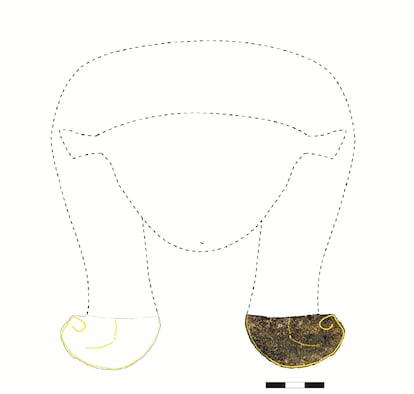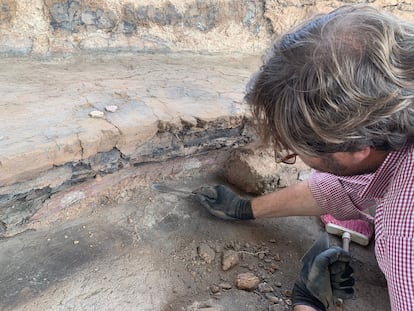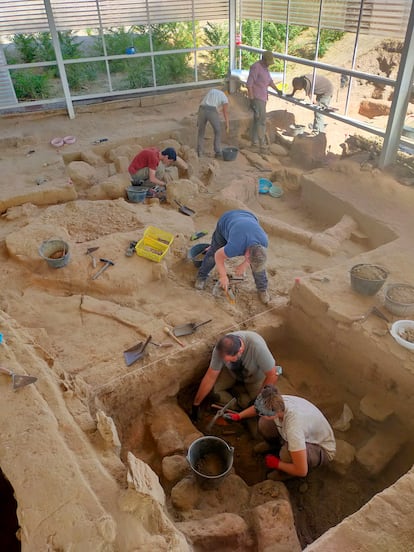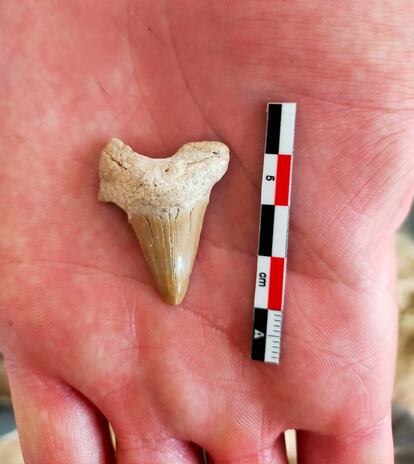‘Puzzling’ archeological find in Spain uncovers objects with Egyptian motifs
Researchers excavating the 2,700-year-old Cerro de San Vicente site unearthed a fragment of a portrait depicting the goddess Hathor, daughter of Ra, god of the sun


About 2,700 years ago, an Iron Age community settled on the Cerro de San Vicente, one of three hills around which the present-day Spanish city of Salamanca is built. For more than three decades, the site has been of major interest to prehistorians and now archeologists have unearthed a surprising new discovery there: a large number of objects, ranging from amulets to painted ceramics, featuring motifs of Egyptian or other eastern Mediterranean origins. The most recent piece exhumed this summer and analyzed under the microscopes of the University of Salamanca is a fragment of an inlay — a piece of faience, or glazed pottery, that ancient Egyptians used as a sort of puzzle piece to depict the faces of their gods — covered in gold leaf. It is the image of the goddess Hathor, daughter of Ra, god of the sun, and mother of Horus, the falcon-headed god.
It is possible that a Phoenician delegation brought these artifacts as gifts or trade items to the residents of what is now Salamanca, in western Spain. But the recent finding raises various unanswered questions. What were these Semitic people doing so far inland? Did the indigenous population of Salamanca adopt the rites and iconography of these eastern Mediterranean cultures?
All the discoveries made at the site on the Cerro de San Vicente are mysterious and surprising. The settlement was a walled village of about 1.3 hectares, sitting on a hill about 30 meters high, next to the Tormes River. Excavations of the site began in 1990, and between two and three meters of archaeological layers have been uncovered and preserved. Researchers have now studied more than one thousand square meters of the site, with 400 square meters protected and on display to the public.
Despite its location in Salamanca’s historic city center, an ideal place for urban expansion, the site has remained protected and in relatively good condition over the decades. In the 19th century, it suffered some collateral destruction at the hands of Napoleon’s troops, who bombarded a nearby medieval convent, and in 1949 a large building (the Colegio Hispanoamericano) was built on the hill’s highest point at what would eventually become the central area of the archeological site. That building was demolished in 2005 to save the site, which is now open to visitors.

Investigations spearheaded by Antonio Blanco and Juan Jesús Padilla, professors of prehistory at the University of Salamanca, and archeologists Carlos Macarro and Cristina Alario, determined that the inhabitants of the hilltop community had, at some point, intentionally set fire to the largest of the houses, with all its objects still inside, between 650 and 575 BC. They then used some of the adobe blocks with which the house was made to seal and cover up the structure.
This circular building — six meters in diameter and known as House 1 — was furnished with two benches and other items of clay furniture and had a capacity for about 20 people. A central fireplace was used to heat the space and inside the house archeologists have uncovered grinding stones, finely painted cookware, instruments for spinning yarn and throwing pottery, as well as exotic objects like beads, faience crockery from the eastern Mediterranean, red engobe pottery, liturgical objects and figurines of apparent Tartessian origin.
“All of these findings indicate that the house was a site of frequent social activity, including banquets and business dealings,” explains Padilla. “The rest of the village featured public squares, granaries, warehouses, large cooking grills, and a rectangular building that resembles a megaron [a kind of temple] with a portico, courtyard and a main hall.”

The curly-haired goddess
Excavations at the site in 2021 uncovered a small blue amulet depicting the Egyptian goddess Hathor but this summer, archeologists discovered a fragment of a spectacular and much larger gold-leaf object, which they believe to be a piece of a portrait of the goddess. To depict the faces of their deities, Egyptians would trace an outline of the character or animal they wanted to represent on a flat surface such as wood, ivory or bone. Then, they would inlay sections of the drawing until the figure was complete, like piecing together a puzzle. The recent discovery is a fragment of about five centimeters and reveals the bottom section of the goddess’s hair, with her curls plainly visible. “Each piece was shaped to fit perfectly into its support base,” Padilla says. “Then, with a kind of resin or adhesive, they were glued into place. We are currently analyzing the piece in our laboratory to see if there are any traces of this glue still on the inner surface, to determine what kind of resin was used.”
The gold leaf puzzle-piece was found inside the site’s main rectangular building, a megaron featuring three rooms connected in a line. The piece had been deliberately placed among the adobe blocks and mud grout of the walls, along with other items like a shark’s tooth, faience necklace beads, and a fragment of a clay amphora featuring floral motifs painted in Egyptian blue. Alario says the team is still investigating to better understand the meaning of the motif. “They’re like little surprises we keep finding as we excavate,” she says. “They might relate to some kind of ritual, but we need to dig deeper to get a better understanding.”

“It’s a very surprising site,” says Macarro. “Why did the inhabitants of an Iron Age settlement have Egyptian artifacts? Did they adopt their rites? I can imagine Phoenicians entering the hilltop settlement carrying these objects, wearing their brightly colored clothing. What would these two peoples have made of each other? It’s very exciting to think about.”
The team of Salamancan archeologists believes that the Phoenicians either arrived via present-day Portugal, following the valleys that lead to Salamanca, or travelled from the south end of the peninsula through the natural corridor and ancient trade and pilgrimage route known as the Vía de la Plata (The silver route). “As is well known, these trading communities not only settled along the Mediterranean coasts of Iberia, but also along the Atlantic coast,” Alario explains. “From there, it would not have been too difficult to travel inland towards the interior, and to enter into contact with the groups that lived in what is now the province of Salamanca.”
Alario points out her favorite of all the objects excavated so far: a selection of circular paintings dotted in white and located under one of the benches in House 1. “We’re studying them to try and understand their meaning and what they wanted to express. They could be a simple decorative motif, or a representation of the planet Venus surrounded by stars.” A literal puzzle, and the pieces are starting to fit together.
Tu suscripción se está usando en otro dispositivo
¿Quieres añadir otro usuario a tu suscripción?
Si continúas leyendo en este dispositivo, no se podrá leer en el otro.
FlechaTu suscripción se está usando en otro dispositivo y solo puedes acceder a EL PAÍS desde un dispositivo a la vez.
Si quieres compartir tu cuenta, cambia tu suscripción a la modalidad Premium, así podrás añadir otro usuario. Cada uno accederá con su propia cuenta de email, lo que os permitirá personalizar vuestra experiencia en EL PAÍS.
¿Tienes una suscripción de empresa? Accede aquí para contratar más cuentas.
En el caso de no saber quién está usando tu cuenta, te recomendamos cambiar tu contraseña aquí.
Si decides continuar compartiendo tu cuenta, este mensaje se mostrará en tu dispositivo y en el de la otra persona que está usando tu cuenta de forma indefinida, afectando a tu experiencia de lectura. Puedes consultar aquí los términos y condiciones de la suscripción digital.
More information
Últimas noticias
Maduro pleads not guilty before the federal court in New York: ‘I am still the president of Venezuela’
A new test can detect Alzheimer’s from a finger prick
UN team enters Sudanese city of El Fasher after paramilitary massacre: ‘It’s like a ghost town’
A recipe for resistance: Indigenous peoples politicize their struggles from the kitchen
Most viewed
- Gilles Lipovetsky: ‘If you want to live better and fall in love, take Prozac, don’t look to philosophy’
- Alain Aspect, Nobel laureate in physics: ‘Einstein was so smart that he would have had to recognize quantum entanglement’
- Alvin Hellerstein, a 92-year-old judge appointed by Bill Clinton, to preside over Maduro’s trial in New York
- Maduro’s downfall puts China’s relationship with Venezuela to the test
- Why oil has been at the center of Venezuela-US conflicts for decades










































